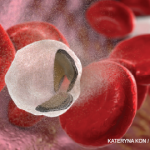Anemia
Dr. Berliner took the stage next, reminding attendees that the most common causes of anemia in SLE are iron deficiency anemia (IDA) and anemia of chronic inflammation (ACI), alone or in combination. Autoimmune hemolytic anemia (AIHA), although often seen in SLE, is far less common.

Dr. Berliner
To distinguish IDA from ACI, Dr. Berliner looks first at ferritin levels. “Ferritin is an acute-phase reactant. But you shouldn’t be able to get a ferritin level over 100 in the setting of IDA,” she said. “Of note, long-standing ACI can cause IDA through hepcidin-induced failure of gastrointestinal iron absorption. If this is the case, iron repletion will be more effective if given intravenously,” she added.
When autoimmune hemolytic anemia (AIHA) is at play in SLE, it is almost always mediated by warm, complement-binding autoantibodies. “Diagnosis is straightforward in that the Coombs’ test will be positive, and the reticulocyte count will be high. Treatment includes steroids and/or rituximab,” she said.
Neutropenia
Dr. Berliner next discussed neutropenia, taking care to differentiate primary autoimmune neutropenia (which is antibody-mediated and primarily seen in children ages six to 12 months) from secondary autoimmune neutropenia (which is mainly seen in adults with underlying autoimmune disease). Dr. Berliner said, “Neutropenia is very common in SLE—nearly 50% of patients—and almost never requires specific therapy. Rather, it’s just a marker of underlying SLE disease activity with little impact on the course of the disease overall. In general, I use clinical symptoms to decide if something needs to be done, and they are virtually never there. Don’t treat the number. Look at the patient and see if they are having recurrent infections. Interestingly, infection risk correlates more with immunosuppression than the neutrophil count in SLE patients.”9
Dr. Berliner closed with a candid pearl: “I’m often asked if anti-neutrophil antibody testing should be sent. The problem with anti-neutrophil antibody testing is that there are many reasons for false positive results, correlation is poor and it’s very difficult to do these studies outside of highly skilled laboratories. So when do I check these in adults with neutropenia? Never.”
Regarding bone marrow biopsy, she said, “I would consider this if the patient had no evidence of active SLE, other counts were low and neutropenia was very severe.”
Macrophage Activation Syndrome
Macrophage activation syndrome (MAS) is a subset of hemophagocytic lymphohistiocytosis (HLH) in the setting of concomitant systemic autoimmune disease. It’s most commonly seen in children (in at least 10% of systemic juvenile idiopathic arthritis), but it’s not restricted to pediatrics.10

